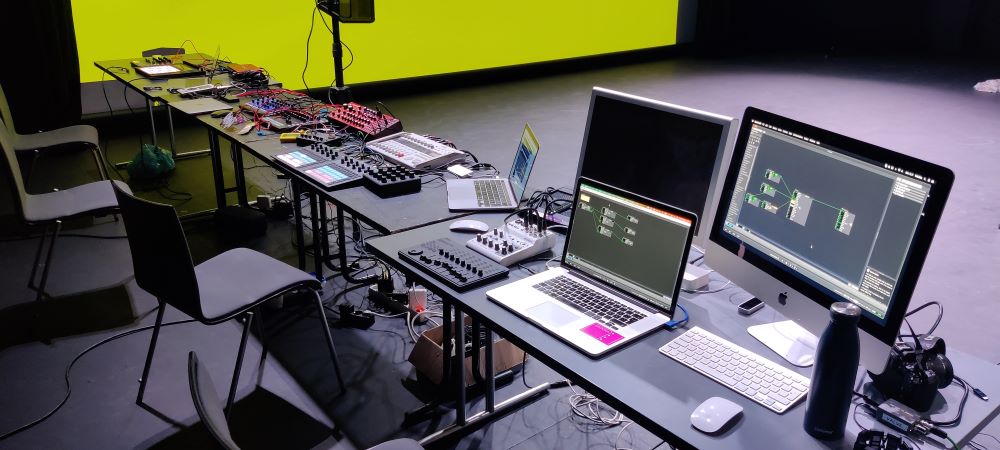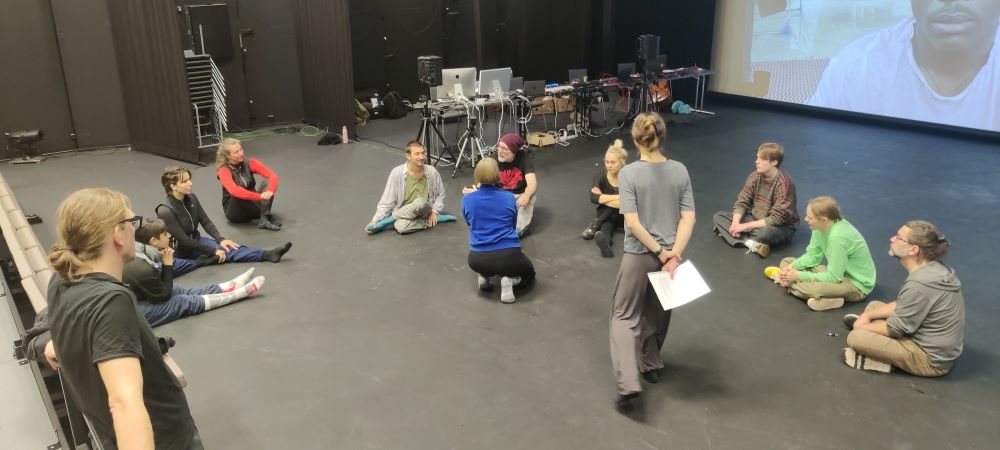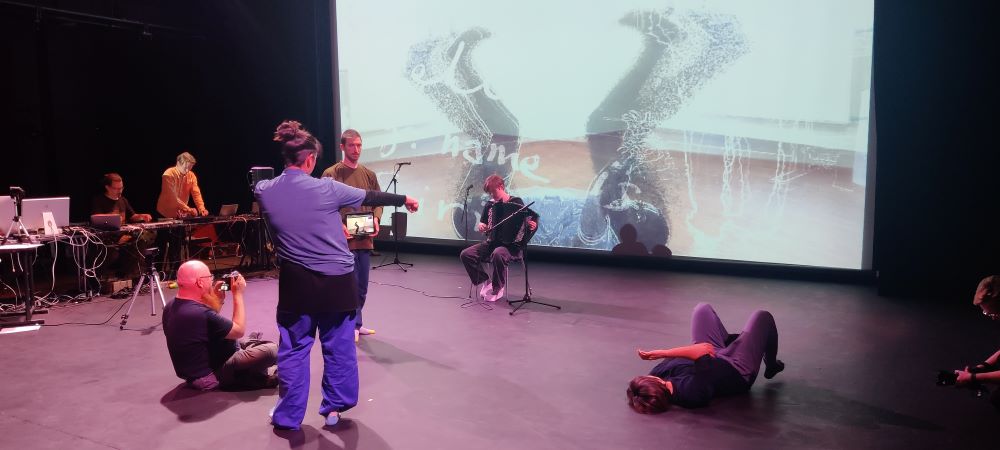From 25th – 29th September, TaikaBox once again organized the Oulu Dance Hack. This unique event combines advanced technology, from robotics to AI, with dancing. This year’s technology was AI, and ICTOulu and OuluHealth were invited to visit. We talked to various participants and enjoyed the intriguing atmosphere of both dancing and tech collaborating seamlessly. The people we interviewed were one of the founders of TaikaBox, two dancers at the event and one online, and a media artist, and we asked their thoughts on using AI in dancing.
John Collingswood – founder of TaikaBox
The Dance Hack is organized by TaikaBox, a music- and dance organization based in Oulu, and founded by choreographer Tanja Råman and video artist John Collingswood.
John explains that the aim of the Dance Hack is to provide local tech businesses with unique opportunities for product development and testing. A good example of that is Probot, that through this collaboration with the Dance Hack got innovative new ideas for their robots. TaikaBox also wants to create deep connections between the freelance cultural sector, Oulu universities and businesses, and give artists the chance to access cutting-edge technology that is being developed in Oulu. The overarching aim is to develop Oulu as an internationally-recognized center for performance and technology. By coordinating the efforts of TaikaBox, OAMK, and the City of Oulu/Oulu2026, they have potential for putting Oulu on the map within the global performance/tech scene.
TaikaBox at Oulu2026
During Oulu2026, TaikaBox will organize Finland’s first festival of augmented dance, John says. For these and similar projects they are constantly searching for local IT and tech businesses who are interested in collaborating. This year’s Dance Hack technology is AI, but each year they want to focus on different technology and build the theme of each event around the technology that they use.
Amit Palgi and Laura Lille – dance artists
Amit is originally from Israel, but currently lives in the Netherlands. He works as a dancer and choreographer, and develops a lot of his creations from the combination of human embodiment and technology. Laura lives in France and is from New Caledonia (a French island close to Australia). She is a dancer, choreographer, and Human System Interface Engineer.
Both Amit and Laura work mainly with contemporary dance, since it’s very open and gives them the freedom to do whatever they want; their focus is more on approaching movement than on a specific style. They prefer to see dancing as working with the body and with movement, without tying it to a style. Laura loves to try out different techniques, for example from ballet and urban dancing.

View on AI and creativity
Amit thinks that mixing AI with humans creates something very interesting, a new tool with an infinite amount of knowledge and possibilities. However, he says we should learn how to deal with this knowledge and amplify the bits we need. Then, we could learn to use it in such a way that it benefits and extends creativity. Laura shares a similar view and sees a paradox in mixing dance with technology; namely that using technology requires a lot of sensitivity. She thinks AI is a really good tool that makes us ask more questions and pushes the limits on our understanding of, for example, what makes us humans. On the other hand, contrary to an artist, AI has no philosophy of why it does something in a certain way. Amit adds that you can ask an AI to create a whole new choreography based on a image or video of someone dancing, which is a great way to learn and push your boundaries. Also, the unexpectedness of the output is really exciting to him, it’s always not what you’d expect.
Development opportunities for IT companies
Using AI in dancing and performing is still very new, Laura says, and it still has many limitations, like the computing time of images and video. She thinks there is still a lot of research to be done on how to interact with AI and how to make it viable.
Tadhi Alawi – dance artist
Tadhi is a dancer and choreographer from the Nantea Dance Company in Dar es Salaam in Tanzania. He often taught at Rafiki NGO in Bagamoyo (a coast town close to Dar es Salaam) and worked closely with alumni from the prestigious Bagamoyo College of Arts.
Tadhi has learned many dancing styles, from afro to street dance and from traditional Tanzanian dance to contemporary. This style mix, together with his background and personal experiences, are reflected in his current dancing style. What started as a passion is now more about the connection with the audience, though of course the passion is still there.
He explains that dancing with AI was completely new to him, since the technology is developing so fast. He wants to find out how we can cope with that speed. AI has made him change his way of thinking about dancing, and how AI can influence dancing itself. Tahdi says he’s still on the journey of understanding how AI works with people, and how dance and AI can be connected. He’s looking forward to using it in the future and wants to experiment with it.
Since Tadhi was not in Finland during the Dance Hack, he joined through a video connection. Instead of a limitation, this became an asset as they applied all kinds of visual effects and sound effects on his video, and overlapped it with the video of the other dancers.

Tomi Knuutila – art- and design senior lecturer and media artist
Tomi is from the faculty of arts and design at the university of Lapland in Rovaniemi, in the audiovisual media and culture department. He’s an art- and design senior lecturer and media artist.
Ever since Tomi was a media student, he’s been involved in tech dance. In Rovaniemi he met John and Tanja, who asked him to join their organization TaikaBox.
Tomi explains how recently, new AI models came out that are faster to run and train, and you can ask for any image with a text-based prompt. This gives almost overwhelming possibilities, and it gives humans a huge opportunity and also responsibility in using them. AI still makes mistakes; it doesn’t always give you what you want, and figuring out what it does want, and comparing that to what you want to express is also interesting.
The AI they’ve used is still biased, Tomi says, since it’s trained with material from our own culture. The image that an AI model has of dancers is for example ballet dancers with tutus, belly dancers, etc., which is not the image that TaikaBox dancers have.
How the Dance Hack can help Oulu-based IT companies
Many Oulu-based companies are currently working on various technologies like robotics, IoT, sensors, and other devices for inside your home. TaikaBox has some of these sensors, which can for example detect exactly how a dancer moves, and where they are in the room. Dancing and the Dance Hack might provide a great testing ground for these companies, and an opportunity to develop their own products in unexpected directions. As mentioned before, Probot worked with the Dance Hack several times. As a result, they have developed a robot that was capable of improvising, instead of just doing as prompted.
A shared concept between dance theatre and programming is the black box; something goes in, something comes out, but you don’t really know what happens inside. It works, but you don’t know how. The people from the Dance Hack think that their event could help opening this box and provide intriguing possibilities for the technology that developers didn’t yet think about.
Text by Arjane Kerkhoven
